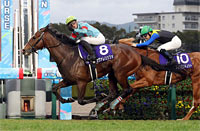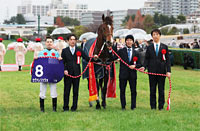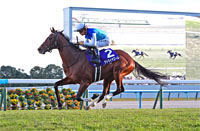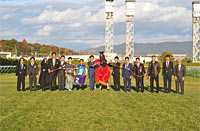Asahi Hai Futurity Stakes (G1) - Data Analysis
Race that determines the 2-year-old mile champion
Do Deuce, who won the Asahi Hai Futurity Stakes in 2021, triumphed in this year’s Tokyo Yushun (Japanese Derby). Similarly, 2018 Asahi Hai Futurity Stakes winner Admire Mars won the NHK Mile Cup of the following spring and the Hong Kong Mile at the end of 2019. Meanwhile, Gran Alegria, who finished 3rd in the 2018 Asahi Hai Futurity Stakes, secured the victory in the Oka Sho (Japanese 1000 Guineas) of the following year, and has since performed well as an older horse, racking up five wins in short-distance G1 races. In other words, this 2-year-old mile champion decider not only provides important hints for G1 races for 3-year-olds in the following year, but also brings together runners that are expected to perform well in later short-distance races. Let’s now analyze some trends in this race based on data since 2014, when the race was moved to Hanshin Racecourse.
Notably stable performance by runners backed as 1st and 2nd favorite
The only runner backed as 1st favorite to be beaten to 4th or lower over the last eight years was Mi Suerte, who finished 4th in 2016. In addition, runners backed as 2nd favorite produced five Top 3 finishers, achieving a high Top 3 ratio of 62.5%. Conversely, runners backed as 4th and 5th favorite performed poorly, with only one of 16 such runners finishing in the Top 3. [Table 1]
[Table 1] Performance by favoritism (last eight years)
| Favoritism |
Performance
[1st-2nd-3rd-4th or lower] |
Win ratio |
Top 2 ratio |
Top 3 ratio |
| 1st favorite |
3-2-2-1 |
37.5% |
62.5% |
87.5% |
| 2nd favorite |
2-2-1-3 |
25.0% |
50.0% |
62.5% |
| 3rd favorite |
1-1-1-5 |
12.5% |
25.0% |
37.5% |
| 4th favorite |
0-0-1-7 |
0% |
0% |
12.5% |
| 5th favorite |
0-0-0-8 |
0% |
0% |
0% |
| 6th-9th favorite |
2-2-0-28 |
6.3% |
12.5% |
12.5% |
| 10th favorite or lower |
0-1-3-54 |
0% |
1.7% |
6.9% |
Watch finish in debut race
Of the 16 Top 2 finishers over the last eight years, 13 had won their debut race, with the remaining three runners having finished 2nd. Conversely, runners that had been beaten to 3rd or lower in their debut race produced zero Top 2 finishers and only three third-place finishers. Picking runners that have finished 1st or 2nd in their debut race is therefore likely to be the smart strategy. [Table 2]
[Table 2] Performance by finish in debut race (last eight years)
| Finish |
Performance
[1st-2nd-3rd-4th or lower] |
Win ratio |
Top 2 ratio |
Top 3 ratio |
| 1st |
5-8-3-54 |
7.1% |
18.6% |
22.9% |
| 2nd |
3-0-2-23 |
10.7% |
10.7% |
17.9% |
| 3rd |
0-0-1-12 |
0% |
0% |
7.7% |
| 4th |
0-0-1-4 |
0% |
0% |
20.0% |
| 5th |
0-0-0-2 |
0% |
0% |
0% |
| 6th-9th |
0-0-1-8 |
0% |
0% |
11.1% |
| 10th or lower |
0-0-0-3 |
0% |
0% |
0% |
Watch position when passing 4th corner in previous race
Seven of the last eight winners had passed the 4th corner of their previous race in 2nd-4th position. Based on the position when passing the 4th corner in the previous race, the bulk of the runners have historically fallen into one of two groups: those in 2nd-4th position (58 in total) and those in 5th-9th position (46). A total of 16 runners from the former group finished in the Top 3 of the Asahi Hai Futurity Stakes. This was more than double the number for the latter group (6). In other words, we should also check the position of runners when passing the 4th corner in their previous race. [Table 3]
[Table 3] Performance by position when passing 4th corner in previous race (last eight years)
| Position |
Performance
[1st-2nd-3rd-4th or lower] |
Win ratio |
Top 2 ratio |
Top 3 ratio |
| Leader |
0-0-1-15 |
0% |
0% |
6.3% |
| 2nd-4th |
7-4-5-42 |
12.1% |
19.0% |
27.6% |
| 5th-9th |
1-3-2-40 |
2.2% |
8.7% |
13.0% |
| 10th or lower |
0-1-0-9 |
0% |
10.0% |
10.0% |
Focus on track record in graded races
Of the 33 runners over the last eight years that had previously won a JRA graded race, 12 finished in the Top 3, achieving a Top 3 ratio of 36.4%. In addition, the 47 runners without experience of contesting a JRA graded race produced seven Top 3 finishers, including five winners. Although runners with previous success in a JRA graded race have the edge in terms of the number of Top 3 finishers and the Top 3 ratio, we should also not overlook runners who will be making their graded race debut in the Asahi Hai Futurity Stakes. In contrast, runners that had experience of contesting a graded race but had only finished 2nd or lower in such a race, struggled, producing a total of five second-place and third-place finishers. This suggests it may be wise to discount runners that have previously contested a graded race but only finished 2nd or lower in such a race. [Table 4]
[Table 4] Performance by highest finish in JRA graded race (last eight years)
| Highest finish |
Performance
[1st-2nd-3rd-4th or lower] |
Win ratio |
Top 2 ratio |
Top 3 ratio |
| 1st |
3-5-4-21 |
9.1% |
24.2% |
36.4% |
| 2nd |
0-1-1-16 |
0% |
5.6% |
11.1% |
| 3rd |
0-0-1-10 |
0% |
0% |
9.1% |
| 4th |
0-1-0-3 |
0% |
25.0% |
25.0% |
| 5th |
0-0-0-2 |
0% |
0% |
0% |
| 6th-9th |
0-1-0-11 |
0% |
8.3% |
8.3% |
| 10th or lower |
0-0-0-3 |
0% |
0% |
0% |
| No graded race contested in the past |
5-0-2-40 |
10.6% |
10.6% |
14.9% |
Seek out the winner!
Check favoritism in the past
Looking at performances by the last eight winners in terms of favoritism in races contested from their debut race to their previous race, we find that the winners had been backed as 2nd favorite or higher in all such races. Runners that have been consistently highly favored since their debut race are therefore potential win contenders. [Table 5]
[Table 5] Winners’ lowest favoritism since debut race (last eight years)
| Year |
Winner |
Lowest favoritism |
| 2014 |
Danon Platina |
1st favorite |
| 2015 |
Leontes |
1st favorite |
| 2016 |
Satono Ares |
2nd favorite |
| 2017 |
Danon Premium |
2nd favorite |
| 2018 |
Admire Mars |
1st favorite |
| 2019 |
Salios |
2nd favorite |
| 2020 |
Grenadier Guards |
2nd favorite |
| 2021 |
Do Deuce |
2nd favorite |
(Michio Kawano)
|



















